HI6028 - Taxation Law: Capital Gains Tax and Income - Case Study
VerifiedAdded on 2023/03/31
|8
|1927
|423
Report
AI Summary
This assignment provides a detailed analysis of various taxation law issues, focusing on capital gains tax (CGT) consequences and income assessment. It examines scenarios involving the sale of antiques, sculptures, jewelry, and pictures to determine CGT liabilities, referencing relevant sections of the Income Tax Assessment Act 1997. Additionally, it assesses whether certain receipts qualify as income from personal exertion, considering court decisions and taxation rulings. The assignment further analyzes the tax implications of interest-free loans and early debt repayment. The document provides comprehensive insights into Australian taxation law and its practical applications. Desklib offers a wealth of similar solved assignments and past papers to aid students in their studies.
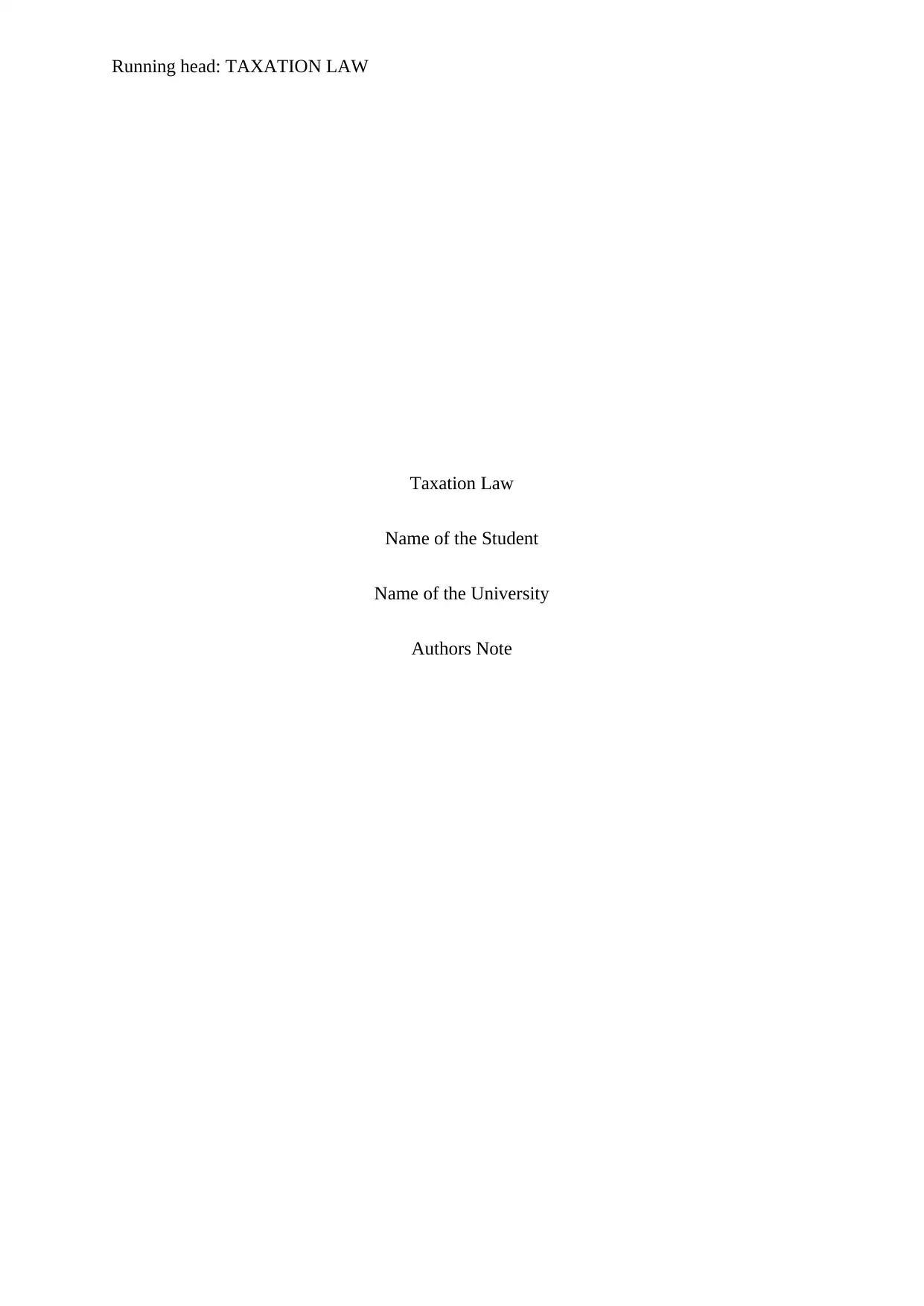
Running head: TAXATION LAW
Taxation Law
Name of the Student
Name of the University
Authors Note
Taxation Law
Name of the Student
Name of the University
Authors Note
Paraphrase This Document
Need a fresh take? Get an instant paraphrase of this document with our AI Paraphraser
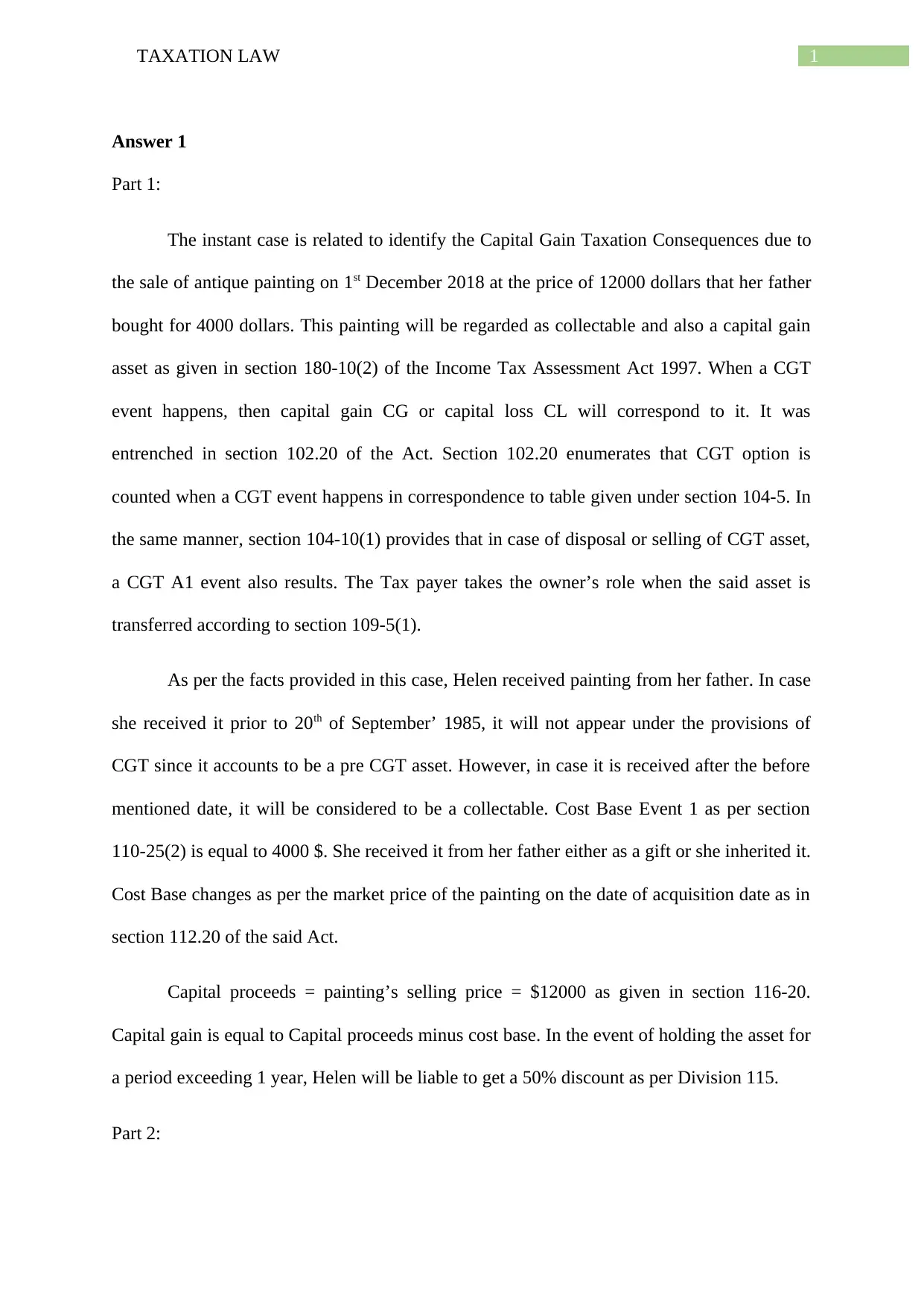
1TAXATION LAW
Answer 1
Part 1:
The instant case is related to identify the Capital Gain Taxation Consequences due to
the sale of antique painting on 1st December 2018 at the price of 12000 dollars that her father
bought for 4000 dollars. This painting will be regarded as collectable and also a capital gain
asset as given in section 180-10(2) of the Income Tax Assessment Act 1997. When a CGT
event happens, then capital gain CG or capital loss CL will correspond to it. It was
entrenched in section 102.20 of the Act. Section 102.20 enumerates that CGT option is
counted when a CGT event happens in correspondence to table given under section 104-5. In
the same manner, section 104-10(1) provides that in case of disposal or selling of CGT asset,
a CGT A1 event also results. The Tax payer takes the owner’s role when the said asset is
transferred according to section 109-5(1).
As per the facts provided in this case, Helen received painting from her father. In case
she received it prior to 20th of September’ 1985, it will not appear under the provisions of
CGT since it accounts to be a pre CGT asset. However, in case it is received after the before
mentioned date, it will be considered to be a collectable. Cost Base Event 1 as per section
110-25(2) is equal to 4000 $. She received it from her father either as a gift or she inherited it.
Cost Base changes as per the market price of the painting on the date of acquisition date as in
section 112.20 of the said Act.
Capital proceeds = painting’s selling price = $12000 as given in section 116-20.
Capital gain is equal to Capital proceeds minus cost base. In the event of holding the asset for
a period exceeding 1 year, Helen will be liable to get a 50% discount as per Division 115.
Part 2:
Answer 1
Part 1:
The instant case is related to identify the Capital Gain Taxation Consequences due to
the sale of antique painting on 1st December 2018 at the price of 12000 dollars that her father
bought for 4000 dollars. This painting will be regarded as collectable and also a capital gain
asset as given in section 180-10(2) of the Income Tax Assessment Act 1997. When a CGT
event happens, then capital gain CG or capital loss CL will correspond to it. It was
entrenched in section 102.20 of the Act. Section 102.20 enumerates that CGT option is
counted when a CGT event happens in correspondence to table given under section 104-5. In
the same manner, section 104-10(1) provides that in case of disposal or selling of CGT asset,
a CGT A1 event also results. The Tax payer takes the owner’s role when the said asset is
transferred according to section 109-5(1).
As per the facts provided in this case, Helen received painting from her father. In case
she received it prior to 20th of September’ 1985, it will not appear under the provisions of
CGT since it accounts to be a pre CGT asset. However, in case it is received after the before
mentioned date, it will be considered to be a collectable. Cost Base Event 1 as per section
110-25(2) is equal to 4000 $. She received it from her father either as a gift or she inherited it.
Cost Base changes as per the market price of the painting on the date of acquisition date as in
section 112.20 of the said Act.
Capital proceeds = painting’s selling price = $12000 as given in section 116-20.
Capital gain is equal to Capital proceeds minus cost base. In the event of holding the asset for
a period exceeding 1 year, Helen will be liable to get a 50% discount as per Division 115.
Part 2:
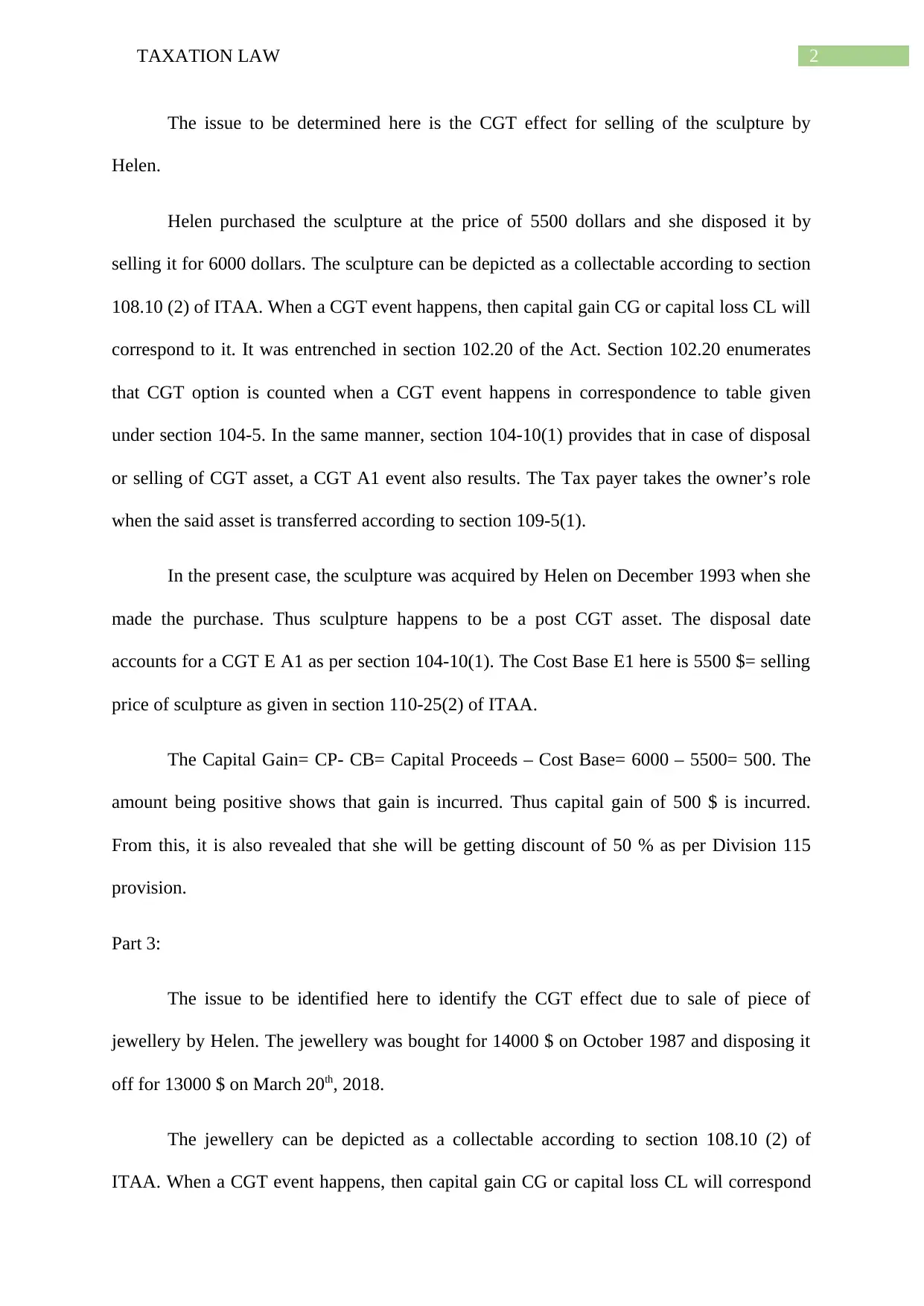
2TAXATION LAW
The issue to be determined here is the CGT effect for selling of the sculpture by
Helen.
Helen purchased the sculpture at the price of 5500 dollars and she disposed it by
selling it for 6000 dollars. The sculpture can be depicted as a collectable according to section
108.10 (2) of ITAA. When a CGT event happens, then capital gain CG or capital loss CL will
correspond to it. It was entrenched in section 102.20 of the Act. Section 102.20 enumerates
that CGT option is counted when a CGT event happens in correspondence to table given
under section 104-5. In the same manner, section 104-10(1) provides that in case of disposal
or selling of CGT asset, a CGT A1 event also results. The Tax payer takes the owner’s role
when the said asset is transferred according to section 109-5(1).
In the present case, the sculpture was acquired by Helen on December 1993 when she
made the purchase. Thus sculpture happens to be a post CGT asset. The disposal date
accounts for a CGT E A1 as per section 104-10(1). The Cost Base E1 here is 5500 $= selling
price of sculpture as given in section 110-25(2) of ITAA.
The Capital Gain= CP- CB= Capital Proceeds – Cost Base= 6000 – 5500= 500. The
amount being positive shows that gain is incurred. Thus capital gain of 500 $ is incurred.
From this, it is also revealed that she will be getting discount of 50 % as per Division 115
provision.
Part 3:
The issue to be identified here to identify the CGT effect due to sale of piece of
jewellery by Helen. The jewellery was bought for 14000 $ on October 1987 and disposing it
off for 13000 $ on March 20th, 2018.
The jewellery can be depicted as a collectable according to section 108.10 (2) of
ITAA. When a CGT event happens, then capital gain CG or capital loss CL will correspond
The issue to be determined here is the CGT effect for selling of the sculpture by
Helen.
Helen purchased the sculpture at the price of 5500 dollars and she disposed it by
selling it for 6000 dollars. The sculpture can be depicted as a collectable according to section
108.10 (2) of ITAA. When a CGT event happens, then capital gain CG or capital loss CL will
correspond to it. It was entrenched in section 102.20 of the Act. Section 102.20 enumerates
that CGT option is counted when a CGT event happens in correspondence to table given
under section 104-5. In the same manner, section 104-10(1) provides that in case of disposal
or selling of CGT asset, a CGT A1 event also results. The Tax payer takes the owner’s role
when the said asset is transferred according to section 109-5(1).
In the present case, the sculpture was acquired by Helen on December 1993 when she
made the purchase. Thus sculpture happens to be a post CGT asset. The disposal date
accounts for a CGT E A1 as per section 104-10(1). The Cost Base E1 here is 5500 $= selling
price of sculpture as given in section 110-25(2) of ITAA.
The Capital Gain= CP- CB= Capital Proceeds – Cost Base= 6000 – 5500= 500. The
amount being positive shows that gain is incurred. Thus capital gain of 500 $ is incurred.
From this, it is also revealed that she will be getting discount of 50 % as per Division 115
provision.
Part 3:
The issue to be identified here to identify the CGT effect due to sale of piece of
jewellery by Helen. The jewellery was bought for 14000 $ on October 1987 and disposing it
off for 13000 $ on March 20th, 2018.
The jewellery can be depicted as a collectable according to section 108.10 (2) of
ITAA. When a CGT event happens, then capital gain CG or capital loss CL will correspond
⊘ This is a preview!⊘
Do you want full access?
Subscribe today to unlock all pages.

Trusted by 1+ million students worldwide
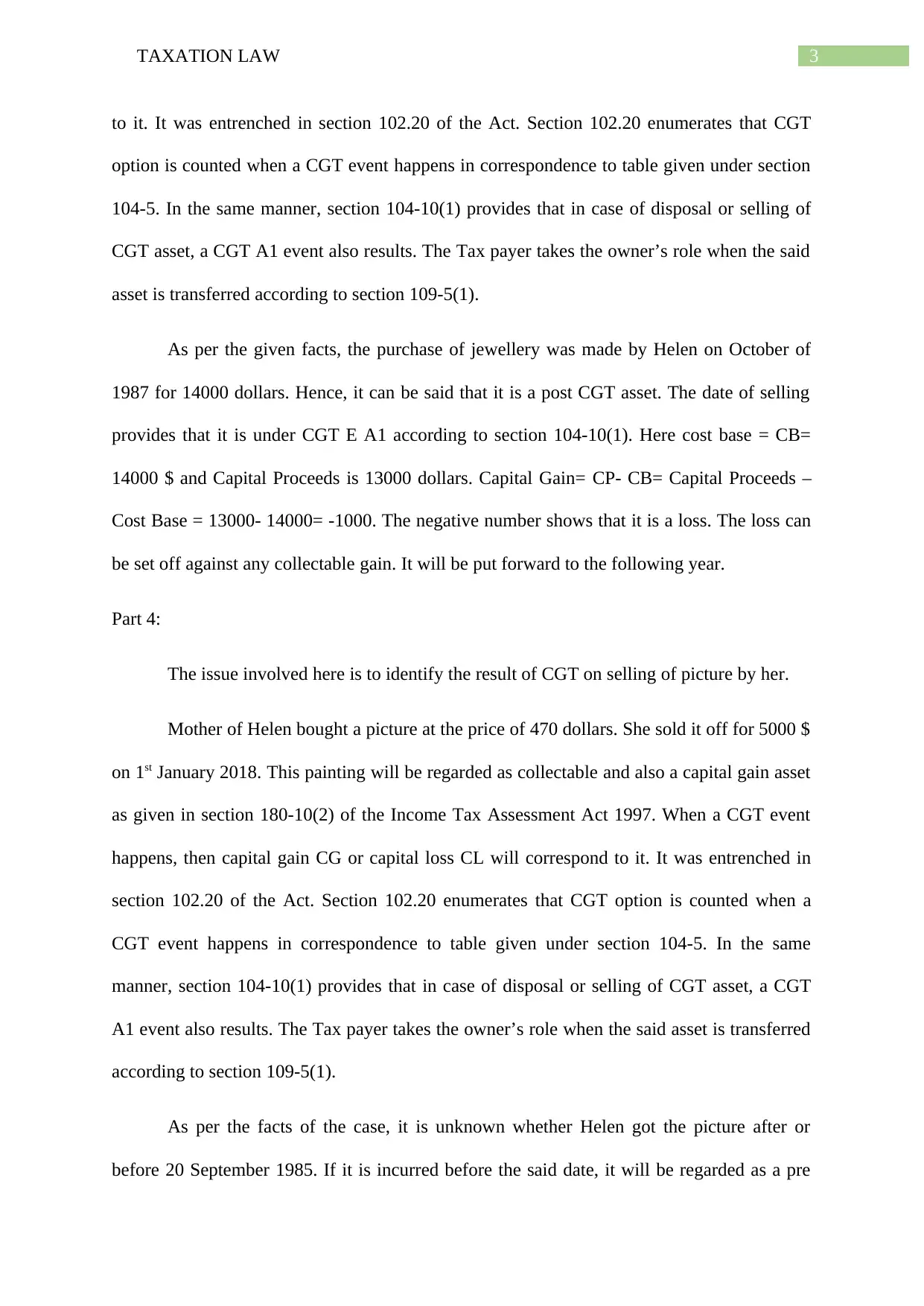
3TAXATION LAW
to it. It was entrenched in section 102.20 of the Act. Section 102.20 enumerates that CGT
option is counted when a CGT event happens in correspondence to table given under section
104-5. In the same manner, section 104-10(1) provides that in case of disposal or selling of
CGT asset, a CGT A1 event also results. The Tax payer takes the owner’s role when the said
asset is transferred according to section 109-5(1).
As per the given facts, the purchase of jewellery was made by Helen on October of
1987 for 14000 dollars. Hence, it can be said that it is a post CGT asset. The date of selling
provides that it is under CGT E A1 according to section 104-10(1). Here cost base = CB=
14000 $ and Capital Proceeds is 13000 dollars. Capital Gain= CP- CB= Capital Proceeds –
Cost Base = 13000- 14000= -1000. The negative number shows that it is a loss. The loss can
be set off against any collectable gain. It will be put forward to the following year.
Part 4:
The issue involved here is to identify the result of CGT on selling of picture by her.
Mother of Helen bought a picture at the price of 470 dollars. She sold it off for 5000 $
on 1st January 2018. This painting will be regarded as collectable and also a capital gain asset
as given in section 180-10(2) of the Income Tax Assessment Act 1997. When a CGT event
happens, then capital gain CG or capital loss CL will correspond to it. It was entrenched in
section 102.20 of the Act. Section 102.20 enumerates that CGT option is counted when a
CGT event happens in correspondence to table given under section 104-5. In the same
manner, section 104-10(1) provides that in case of disposal or selling of CGT asset, a CGT
A1 event also results. The Tax payer takes the owner’s role when the said asset is transferred
according to section 109-5(1).
As per the facts of the case, it is unknown whether Helen got the picture after or
before 20 September 1985. If it is incurred before the said date, it will be regarded as a pre
to it. It was entrenched in section 102.20 of the Act. Section 102.20 enumerates that CGT
option is counted when a CGT event happens in correspondence to table given under section
104-5. In the same manner, section 104-10(1) provides that in case of disposal or selling of
CGT asset, a CGT A1 event also results. The Tax payer takes the owner’s role when the said
asset is transferred according to section 109-5(1).
As per the given facts, the purchase of jewellery was made by Helen on October of
1987 for 14000 dollars. Hence, it can be said that it is a post CGT asset. The date of selling
provides that it is under CGT E A1 according to section 104-10(1). Here cost base = CB=
14000 $ and Capital Proceeds is 13000 dollars. Capital Gain= CP- CB= Capital Proceeds –
Cost Base = 13000- 14000= -1000. The negative number shows that it is a loss. The loss can
be set off against any collectable gain. It will be put forward to the following year.
Part 4:
The issue involved here is to identify the result of CGT on selling of picture by her.
Mother of Helen bought a picture at the price of 470 dollars. She sold it off for 5000 $
on 1st January 2018. This painting will be regarded as collectable and also a capital gain asset
as given in section 180-10(2) of the Income Tax Assessment Act 1997. When a CGT event
happens, then capital gain CG or capital loss CL will correspond to it. It was entrenched in
section 102.20 of the Act. Section 102.20 enumerates that CGT option is counted when a
CGT event happens in correspondence to table given under section 104-5. In the same
manner, section 104-10(1) provides that in case of disposal or selling of CGT asset, a CGT
A1 event also results. The Tax payer takes the owner’s role when the said asset is transferred
according to section 109-5(1).
As per the facts of the case, it is unknown whether Helen got the picture after or
before 20 September 1985. If it is incurred before the said date, it will be regarded as a pre
Paraphrase This Document
Need a fresh take? Get an instant paraphrase of this document with our AI Paraphraser
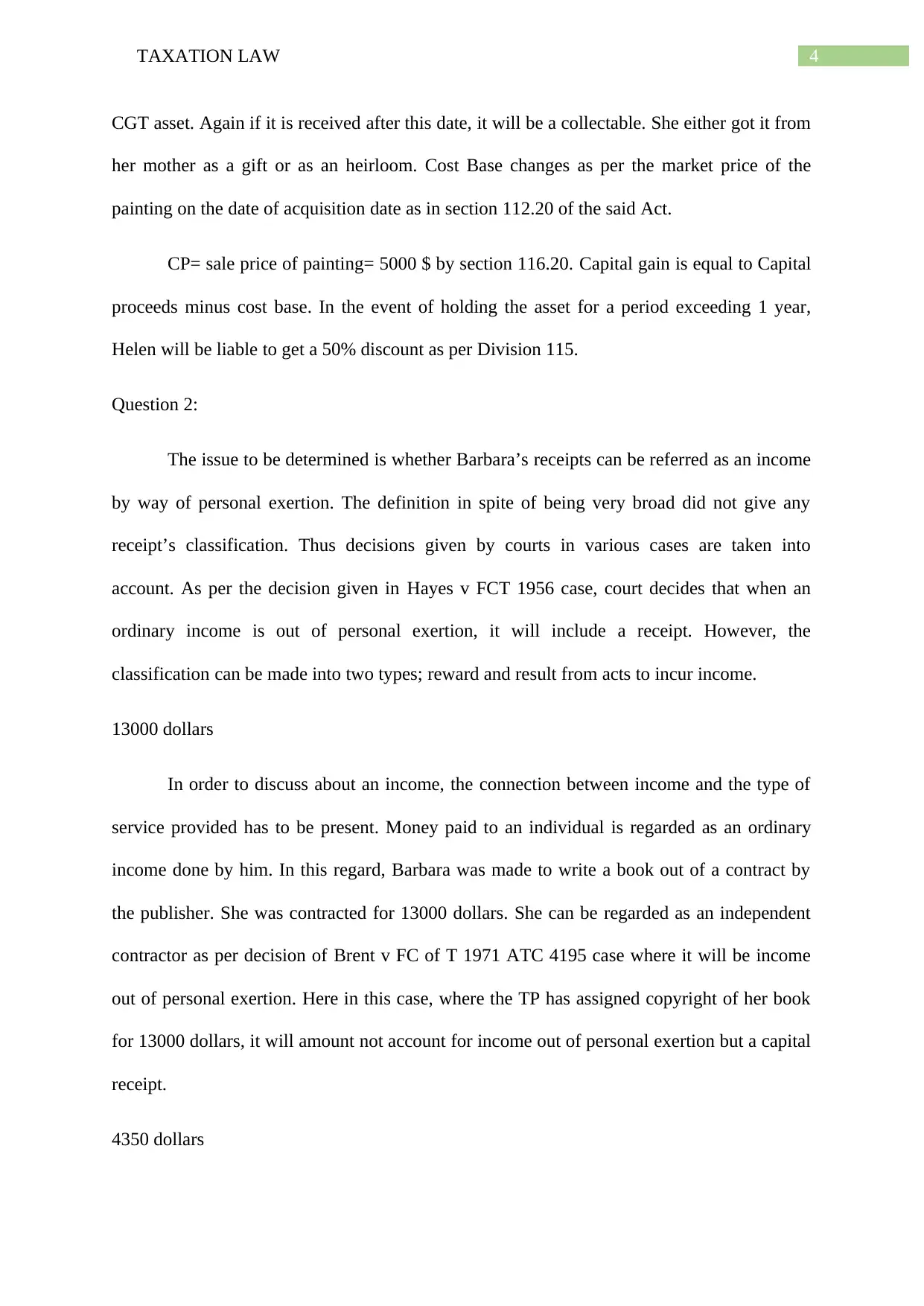
4TAXATION LAW
CGT asset. Again if it is received after this date, it will be a collectable. She either got it from
her mother as a gift or as an heirloom. Cost Base changes as per the market price of the
painting on the date of acquisition date as in section 112.20 of the said Act.
CP= sale price of painting= 5000 $ by section 116.20. Capital gain is equal to Capital
proceeds minus cost base. In the event of holding the asset for a period exceeding 1 year,
Helen will be liable to get a 50% discount as per Division 115.
Question 2:
The issue to be determined is whether Barbara’s receipts can be referred as an income
by way of personal exertion. The definition in spite of being very broad did not give any
receipt’s classification. Thus decisions given by courts in various cases are taken into
account. As per the decision given in Hayes v FCT 1956 case, court decides that when an
ordinary income is out of personal exertion, it will include a receipt. However, the
classification can be made into two types; reward and result from acts to incur income.
13000 dollars
In order to discuss about an income, the connection between income and the type of
service provided has to be present. Money paid to an individual is regarded as an ordinary
income done by him. In this regard, Barbara was made to write a book out of a contract by
the publisher. She was contracted for 13000 dollars. She can be regarded as an independent
contractor as per decision of Brent v FC of T 1971 ATC 4195 case where it will be income
out of personal exertion. Here in this case, where the TP has assigned copyright of her book
for 13000 dollars, it will amount not account for income out of personal exertion but a capital
receipt.
4350 dollars
CGT asset. Again if it is received after this date, it will be a collectable. She either got it from
her mother as a gift or as an heirloom. Cost Base changes as per the market price of the
painting on the date of acquisition date as in section 112.20 of the said Act.
CP= sale price of painting= 5000 $ by section 116.20. Capital gain is equal to Capital
proceeds minus cost base. In the event of holding the asset for a period exceeding 1 year,
Helen will be liable to get a 50% discount as per Division 115.
Question 2:
The issue to be determined is whether Barbara’s receipts can be referred as an income
by way of personal exertion. The definition in spite of being very broad did not give any
receipt’s classification. Thus decisions given by courts in various cases are taken into
account. As per the decision given in Hayes v FCT 1956 case, court decides that when an
ordinary income is out of personal exertion, it will include a receipt. However, the
classification can be made into two types; reward and result from acts to incur income.
13000 dollars
In order to discuss about an income, the connection between income and the type of
service provided has to be present. Money paid to an individual is regarded as an ordinary
income done by him. In this regard, Barbara was made to write a book out of a contract by
the publisher. She was contracted for 13000 dollars. She can be regarded as an independent
contractor as per decision of Brent v FC of T 1971 ATC 4195 case where it will be income
out of personal exertion. Here in this case, where the TP has assigned copyright of her book
for 13000 dollars, it will amount not account for income out of personal exertion but a capital
receipt.
4350 dollars
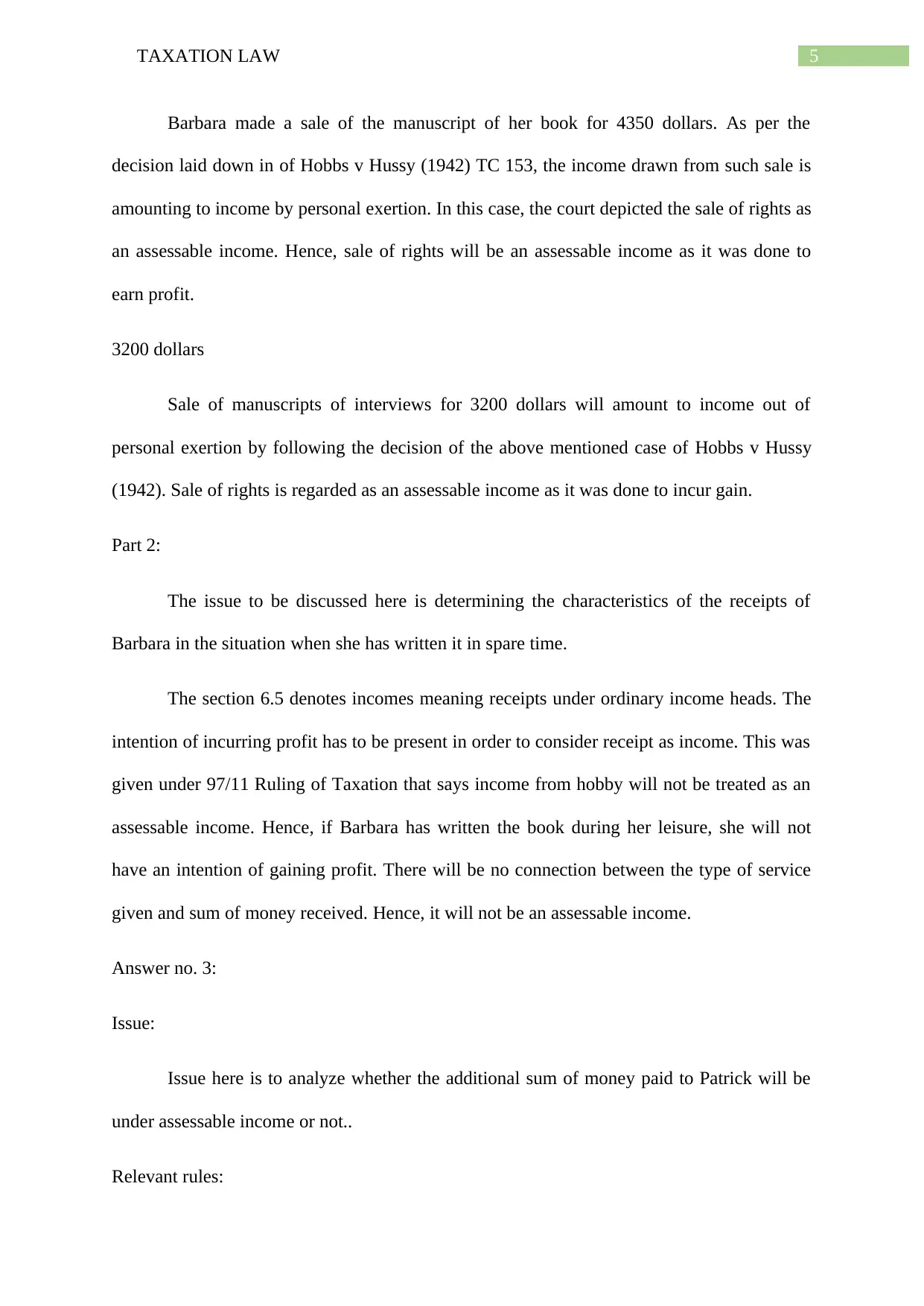
5TAXATION LAW
Barbara made a sale of the manuscript of her book for 4350 dollars. As per the
decision laid down in of Hobbs v Hussy (1942) TC 153, the income drawn from such sale is
amounting to income by personal exertion. In this case, the court depicted the sale of rights as
an assessable income. Hence, sale of rights will be an assessable income as it was done to
earn profit.
3200 dollars
Sale of manuscripts of interviews for 3200 dollars will amount to income out of
personal exertion by following the decision of the above mentioned case of Hobbs v Hussy
(1942). Sale of rights is regarded as an assessable income as it was done to incur gain.
Part 2:
The issue to be discussed here is determining the characteristics of the receipts of
Barbara in the situation when she has written it in spare time.
The section 6.5 denotes incomes meaning receipts under ordinary income heads. The
intention of incurring profit has to be present in order to consider receipt as income. This was
given under 97/11 Ruling of Taxation that says income from hobby will not be treated as an
assessable income. Hence, if Barbara has written the book during her leisure, she will not
have an intention of gaining profit. There will be no connection between the type of service
given and sum of money received. Hence, it will not be an assessable income.
Answer no. 3:
Issue:
Issue here is to analyze whether the additional sum of money paid to Patrick will be
under assessable income or not..
Relevant rules:
Barbara made a sale of the manuscript of her book for 4350 dollars. As per the
decision laid down in of Hobbs v Hussy (1942) TC 153, the income drawn from such sale is
amounting to income by personal exertion. In this case, the court depicted the sale of rights as
an assessable income. Hence, sale of rights will be an assessable income as it was done to
earn profit.
3200 dollars
Sale of manuscripts of interviews for 3200 dollars will amount to income out of
personal exertion by following the decision of the above mentioned case of Hobbs v Hussy
(1942). Sale of rights is regarded as an assessable income as it was done to incur gain.
Part 2:
The issue to be discussed here is determining the characteristics of the receipts of
Barbara in the situation when she has written it in spare time.
The section 6.5 denotes incomes meaning receipts under ordinary income heads. The
intention of incurring profit has to be present in order to consider receipt as income. This was
given under 97/11 Ruling of Taxation that says income from hobby will not be treated as an
assessable income. Hence, if Barbara has written the book during her leisure, she will not
have an intention of gaining profit. There will be no connection between the type of service
given and sum of money received. Hence, it will not be an assessable income.
Answer no. 3:
Issue:
Issue here is to analyze whether the additional sum of money paid to Patrick will be
under assessable income or not..
Relevant rules:
⊘ This is a preview!⊘
Do you want full access?
Subscribe today to unlock all pages.

Trusted by 1+ million students worldwide
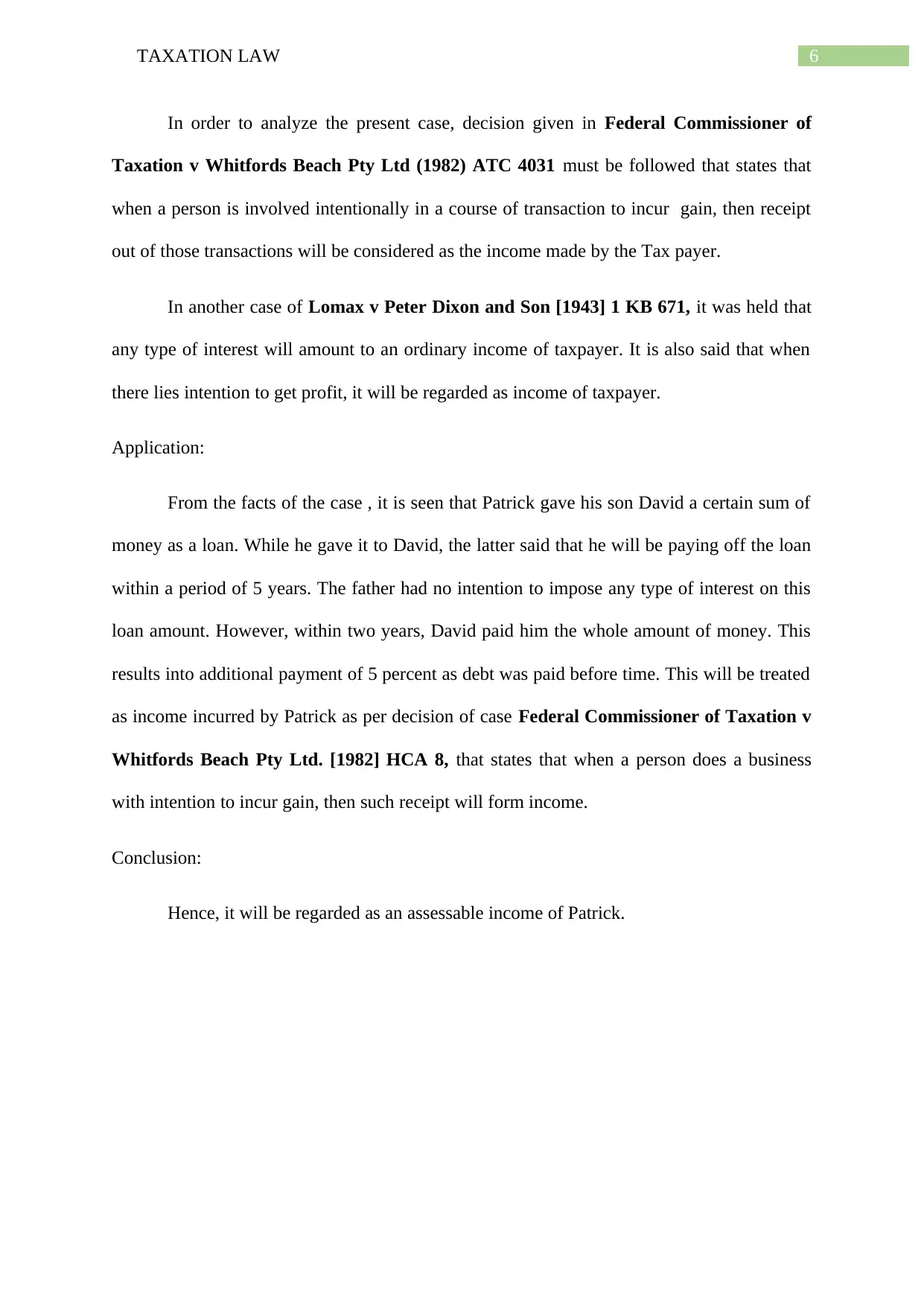
6TAXATION LAW
In order to analyze the present case, decision given in Federal Commissioner of
Taxation v Whitfords Beach Pty Ltd (1982) ATC 4031 must be followed that states that
when a person is involved intentionally in a course of transaction to incur gain, then receipt
out of those transactions will be considered as the income made by the Tax payer.
In another case of Lomax v Peter Dixon and Son [1943] 1 KB 671, it was held that
any type of interest will amount to an ordinary income of taxpayer. It is also said that when
there lies intention to get profit, it will be regarded as income of taxpayer.
Application:
From the facts of the case , it is seen that Patrick gave his son David a certain sum of
money as a loan. While he gave it to David, the latter said that he will be paying off the loan
within a period of 5 years. The father had no intention to impose any type of interest on this
loan amount. However, within two years, David paid him the whole amount of money. This
results into additional payment of 5 percent as debt was paid before time. This will be treated
as income incurred by Patrick as per decision of case Federal Commissioner of Taxation v
Whitfords Beach Pty Ltd. [1982] HCA 8, that states that when a person does a business
with intention to incur gain, then such receipt will form income.
Conclusion:
Hence, it will be regarded as an assessable income of Patrick.
In order to analyze the present case, decision given in Federal Commissioner of
Taxation v Whitfords Beach Pty Ltd (1982) ATC 4031 must be followed that states that
when a person is involved intentionally in a course of transaction to incur gain, then receipt
out of those transactions will be considered as the income made by the Tax payer.
In another case of Lomax v Peter Dixon and Son [1943] 1 KB 671, it was held that
any type of interest will amount to an ordinary income of taxpayer. It is also said that when
there lies intention to get profit, it will be regarded as income of taxpayer.
Application:
From the facts of the case , it is seen that Patrick gave his son David a certain sum of
money as a loan. While he gave it to David, the latter said that he will be paying off the loan
within a period of 5 years. The father had no intention to impose any type of interest on this
loan amount. However, within two years, David paid him the whole amount of money. This
results into additional payment of 5 percent as debt was paid before time. This will be treated
as income incurred by Patrick as per decision of case Federal Commissioner of Taxation v
Whitfords Beach Pty Ltd. [1982] HCA 8, that states that when a person does a business
with intention to incur gain, then such receipt will form income.
Conclusion:
Hence, it will be regarded as an assessable income of Patrick.
Paraphrase This Document
Need a fresh take? Get an instant paraphrase of this document with our AI Paraphraser

7TAXATION LAW
References:
Federal Commissioner of Taxation v Whitfords Beach Pty Ltd (1982) ATC 4031
Federal Commissioner of Taxation v Whitfords Beach Pty Ltd. [1982] HCA 8
Lomax v Peter Dixon and Son [1943] 1 KB 671
Taxation Ruling 97/11
The Income Tax Assessment Act 1936
The Income Tax Assessment Act 1997
References:
Federal Commissioner of Taxation v Whitfords Beach Pty Ltd (1982) ATC 4031
Federal Commissioner of Taxation v Whitfords Beach Pty Ltd. [1982] HCA 8
Lomax v Peter Dixon and Son [1943] 1 KB 671
Taxation Ruling 97/11
The Income Tax Assessment Act 1936
The Income Tax Assessment Act 1997
1 out of 8
Related Documents
Your All-in-One AI-Powered Toolkit for Academic Success.
+13062052269
info@desklib.com
Available 24*7 on WhatsApp / Email
![[object Object]](/_next/static/media/star-bottom.7253800d.svg)
Unlock your academic potential
Copyright © 2020–2025 A2Z Services. All Rights Reserved. Developed and managed by ZUCOL.




